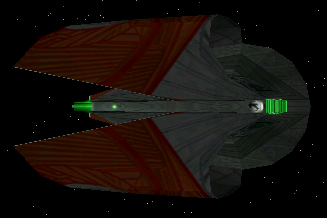Seahawk class (SFC)
The smallest of the third generation of Romulan ships, the Seahawk (SEA) class entered service in 2268, long after its larger brethren. This was acceptable because the Romulan shipbuilding program was very expansive and a large number of older ships, primarily Snipe class frigates, were already available. The Seahawk was never produced in significant numbers, due to the fact that frigates were already becoming tactically obsolete by the time they were introduced. Most were consigned to escort duties and to other non-fleet missions. The SEA featured a crew complement of 160, a capacity of five shuttlecraft, and was equipped with two science labs, two transporters, and two tractor beam emitters. The SEA was armed with two Type-F plasma torpedo tubes, three banks of Type-1 phasers, and two banks of Type-3 phasers.
The Seahawk-L (SEL) frigate leader was introduced in 2271 and was designed to lead frigate squadrons. The additional cost to build the command and control systems did not provide enough of a preformance gain to justify a large purchase order, however, and only a few were produced. Most of those built were destroyed early on in the General War. The SEL featured a crew complement of 180, a capacity of five shuttlecraft, and was equipped with two science labs, two transporters, and two tractor beam emitters. The SEA was armed with one Type-G and two Type-F plasma torpedo tubes, three banks of Type-1 phasers, and two banks of Type-3 phasers.
The Seahawk-G (SEG) troop transport, introduced in 2273, suffered from all of the problems of other Seahawk class vessels, and it was produced too late in order to make a difference. The few ships of the class that were built, however, were largely used for a variety of resupply and relief roles. The SEG featured a crew complement of 220 — including 135 Marines housed in two barracks — a capacity of six shuttlecraft, and was equipped with two cargo units, two science labs, three transporters, and two tractor beam emitters. The SEA was armed with three banks of Type-1 phasers and two banks of Type-3 phasers.[1]
Seahawk class vessels
SFC Timeline
R.I.S. Bravery • R.I.S. Determination • R.I.S. Fervently • R.I.S. Forgiveness • R.I.S. Honesty • R.I.S. Hospadar • R.I.S. Hostility • R.I.S. Lithophyte • R.I.S. Loyalty • R.I.S. Ready • R.I.S. Speedy • R.I.S. Stalwartly • R.I.S. Tenacity • R.I.S. Truly • R.I.S. Trusty • R.I.S. Vesuvius
Notes and References
- ↑ Bethke, Erik (Producer). Starfleet Command. Lead Designer: Erik Bethke. Senior Designer: Chris Taylor. Mission Scripting by Lance Watanabe. Campaign Mission Design by Scott Bennie. Game Design by Marc Hertogh and Tom Hughes. SFB Consultant: Tom Hughes. Interplay Inc.. 15 September 1999.

